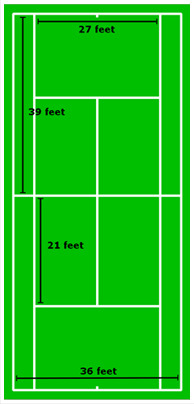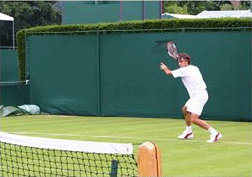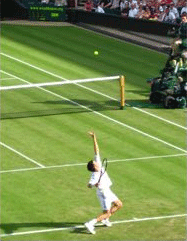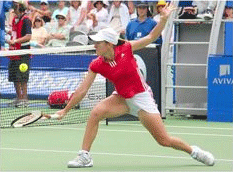History :
The modern game of tennis originated in the United Kingdom in the late 19th century as "lawn tennis" and had heavy connections to the ancient game of real tennis. After its creation, tennis spread throughout the upper-class English-speaking population before spreading around the world. Tennis is an Olympic sport and is played at all levels of society at all ages. The sport can be played by anyone who can hold a racket, including people in wheelchairs. In the United States, there is a collegiate circuit organized by the National Collegiate Athletics Association.
Along with its millions of players, millions of people worldwide follow tennis as a spectator sport, especially the four Grand Slam tournaments (sometimes referred to as the "majors"): Australian Open, Roland Garros (French Open), Wimbledon (UK), and the U.S. Open.
Tennis Court :
Tennis is played on a rectangular, flat surface, usually grass, clay, or a hardcourt of concrete and/or asphalt. The court is 78 feet long, and its width is 27 feet for singles matches and 36 ft for doubles matches. Additional clear space around the court is required in order for players to reach overrun balls. A net is stretched across the full width of the court dividing it into two equal ends. The net is 3 feet 6 inches high at the posts and 3 feet high in the center.

Basic Rules of Tennis:
A game of tennis is played with the aim of scoring points by striking the ball in a way that an opponent can not successfully return it. Service courts are boxes on the either side of the net. The service court on the player's right is known as the deuce court, while the service court on the left is known as the advantage court, or ad court for short. A tennis game is commenced with the server from one team tossing the ball into the air and hitting it with a racquet. The goal is to send the ball in a diagonal direction so that it lands in the receiver's deuce court. When the first point of the game is made, players move to the left and continue play from the advantage court. They then continue to alternate between courts after each point is made until the game has been won.
The players (or teams) start on opposite sides of the net. One player is designated the server, and the opposing player, or in doubles one of the opposing players, is the receiver. Service alternates between the two halves of the court. For each point, the server starts behind his baseline, between the center mark and the sideline. The receiver may start anywhere on their side of the net. When the receiver is ready, the server will serve, although the receiver must play to the pace of the server.
In a legal service, the ball travels over the net (without touching it) and into the diagonally opposite service box. If the ball hits the net but lands in the service box, this is a let or net service, which is void, and the server gets to retake that serve. The player can serve any number of let services in a point and they are always treated as voids and not as faults. A fault is a serve which is long wide, or not over the net (barring a 'foot fault ' ) If the second service is also faulty, this is a double fault, and the receiver wins the point. However, if the serve is in, it is considered a legal service.
A legal service starts a rally, in which the players alternate hitting the ball across the net. A legal return consists of the player or team hitting the ball exactly once before it has bounced twice or hit any fixtures except the net, provided that it still falls in the server's court. The ball then travels back over the net and bounces in the court on the opposite side. The first player or team to fail to make a legal return loses the point.
A tennis match comprises a number of sets, typically first to two for both men's and women's matches, the exception being at the major events (Grand Slam tournaments) where the men play first to three sets.[28] A set consists of a number of games, and games, in turn, consist of points.
A game consists of a sequence of points played with the same player serving. A game is won by the first player to have won at least four points in total and at least two points more than his opponent. The running score of each game is described in a manner particular to tennis: scores of zero to three points are described as "love" (or zero), "fifteen," "thirty," and "forty" respectively. (derived from the French Language ) . If at least three points have been scored by each player, and the scores are equal, the score is "deuce". If at least three points have been scored by each side and a player has one more point than his opponent, the score of the game is "advantage" for the player in the lead. During informal games, "advantage" can also be called "ad in" or "ad out", depending on whether the serving player or receiving player is ahead, respectively .
In tournament play, the chair umpire calls the point count (e.g., "fifteen-love") after each point. The score of a tennis match during play is always read with the serving player's score first. After a match, the score is always read with the winning player's score first. At the end of a game, the chair umpire also announces the winner of the game and the overall score.
A game point occurs in tennis whenever the player who is in the lead in the game needs only one more point to win the game. The terminology is extended to sets (set point), matches (match point), and even championships (championship point). For example, if the player who is serving has a score of 40-love, he has a triple game point (triple set point, etc.) as he has three chances to win the game. Game points, set points, and match points are not part of official scoring and are not announced by the chair umpire in tournament play.
A break point occurs if the receiver, not the server, has a game point. Break points are of importance in professional tennis, since serving is generally advantageous in the men's game.It may happen that the player who is in the lead in the game has more than one chance to score the winning point, even if his opponent should take the next point(s). For example, if the player who is serving has a score of 15–40, the receiver has a double break point. If the player in the lead wins any of the next two points, that player wins the game. As with game, set and match points, break points are not announced.
A set consists of a sequence of games played with service alternating between games, ending when the count of games won meets certain criteria. Typically, a player wins a set when he wins at least six games and at least two games more than his opponent. If one player has won six games, and his opponent five, a further game is played. If the leading player wins the game, he also wins the set (7–5). If the trailing player wins, a tiebreaker is played. A tiebreaker, played under a separate set of rules, allows one player to win one more game and thus the set, to give a final set score of 7–6. Only in the final sets of matches at the Australian Open, the French Open, Wimbledon, Davis Cup, and Fed Cup are tie-breaks not played. In these cases, sets are played indefinitely until one player has a two game lead. A "love" set means that the loser of the set won zero games. In tournament play, the chair umpire announces the winner of the set and the overall score.
Matches consist of an odd number of sets, the match winner being the player who wins more than half of the sets. The match ends as soon as this winning condition is met. Some men's matches may consist of five sets (the winner being the first to win three sets), while most matches are three sets (the winner being the first to win two sets). In tournament play, the chair umpire announces the end of the match with the well-known phrase "Game, set, match" followed by the winning team's name.
Basic Strokes of Tennis :
Forehand
For a right-handed player, the forehand is a stroke that begins on the right side of the body, continues across the body as contact is made with the ball, and ends on the left side of the body. There are various grips for executing the forehand and their popularity has fluctuated over the years. The most important ones are the continental, the eastern, the semi-western, and the western.No matter which grip is used, most forehands are generally executed with one hand holding the racquet, but there have been fine players with two-handed forehands.Currently, France's Fabrice Santoro uses a two-handed forehand. Some females such as Monica Seles and France's Marion Bartoli also use a two-handed forehand.

Roger Federer preparing to hit a forehand.
Backhand
For right-handed players, the backhand is a stroke that begins on the left side of their body, continues across their body as contact is made with the ball, and ends on the right side of their body. It can be executed with either one hand or with both and is generally considered more difficult to master than the forehand.Two hands give the player more power, while one hand can generate a slice shot, applying backspin on the ball to produce a low trajectory bounce.
Serve
A serve (or, more formally, a "service") in tennis is a shot to start a point. The serve is initiated by tossing the ball into the air and hitting it (usually near the apex of its trajectory) into the diagonally opposite service box without touching the net. The serve may be hit under- or overhand.Experienced players strive to master the conventional overhand serve to maximize its power and placement. The server may employ different types of serve including flat serve, topspin serve, slice serve and kick (American twist) serve.Some servers are content to use the serve simply to initiate the point; however, advanced players often try to hit a winning shot with their serve. A winning serve that is not touched by the opponent is called an "ace." If the receiver manages to touch it but fails to successfully return it, it is called a "service winner."

Tim Henman preparing to hit a serve. The left arm is extended, having just launched the ball into the air. The right arm will be raised up and forward at speed so that the racket connects with the ball.
Other shots

Justine Henin performing a backhand volley.
A volley is made in the air before the ball bounces, generally near the net, and is usually made with a stiff-wristed punching motion to hit the ball into an open area of the opponent's court. The half volley is made by hitting the ball on the rise just after it has bounced, once again generally in the vicinity of the net. The swinging volley is hit out of the air as the player approaches the net. It is an offensive shot used to take preparation time away from the opponent. From a poor defensive position on the baseline, the lob can be used as either an offensive or defensive weapon, hitting the ball high and deep into the opponent's court to either enable the lobber to get into better defensive position or to win the point outright by hitting it over the opponent's head. If the lob is not hit deeply enough into the other court, however, the opponent may then hit an overhead smash, a hard, serve-like shot, to try to end the point. Finally, if an opponent is deep in his court, a player may suddenly employ an unexpected drop shot, softly tapping the ball just over the net so that the opponent is unable to run in fast enough to retrieve it.
Tournaments
Tournaments are often organized by gender and number of players. Common tournament configurations include men's singles, women's singles, and doubles, where two players play on each side of net. Tournaments may be arranged for specific age groups, with upper age limits for youth and lower age limits for senior players. There are also tournaments for players with disabilities, such as wheelchair tennis and deaf tennis.[33] In the four Grand Slam tournaments, the singles draws are limited to 128 people for each gender.
Players may also be matched by their skill level. According to how well a person does in sanctioned play, a player is given a rating that is adjusted periodically to maintain competitive matches. For example, the United States Tennis Association administers the National Tennis Rating Program, which rates players between 1.0 and 7.0 in 1/2 point increments. Average club players under this system would rate 3.0-4.5 while world class players would be 7.0 on this scale.
Greatest male singles players ...
A frequent topic of discussion among tennis fans and commentators is who was the greatest male singles player of all time. No consensus has ever existed, however.During the open era, first Rod Laver and then more recently Björn Borg and Pete Sampras were regarded by many of their contemporaries as among the greatest ever. Mats Wilander said, "The greatest player ever is not necessarily the player who has won the most. I would say that Björn Borg is the greatest player ever because he won Wimbledon five times in a row. And out of those five times, he won the French Open all of those five years, plus another year." Laver has said that Sampras is "equal to anyone who has ever played the game." John McEnroe has said that either Laver or Sampras is the greatest player ever. Roger Federer, Rafael Nadal and Novak Djokovic are now considered by many observers to be the greatest of all time in modern tennis, with the potential to surpass the achievements of these past greats. Carlos Alcaraz is the hottest phenomenon right now in men's tennis with quite a complete game, including net-play, and sheer athleticism. Alexander Zverev, Daniil Medvedev and Jannik Sinner are other notable young talents taking the tennis world by storm. Iga Swiatek is the buzziest young women's tennis player in the world as of 2022.
